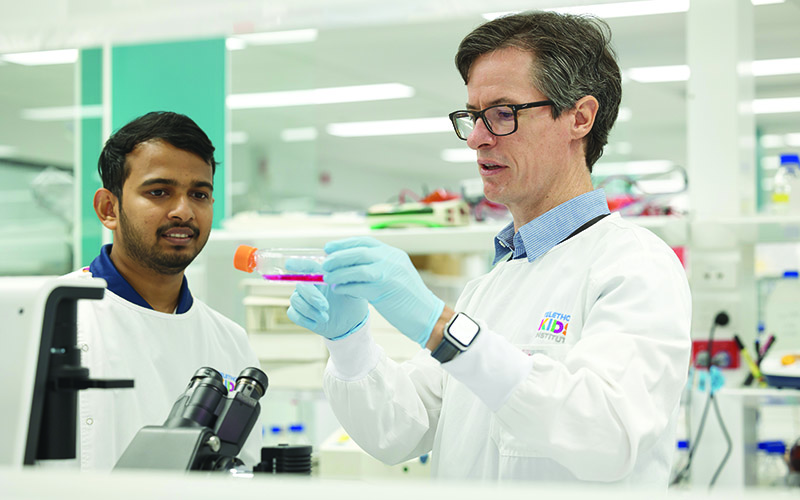It was dubbed humankind’s single greatest victory over disease, but less than a century on from Scottish physician Alexander Fleming’s 1928 discovery of penicillin, the world is perilously close to squandering the miracle of antibiotics.
Although still a staple of modern medicine, the benefits of antibiotics are swiftly waning thanks to overuse and the increasing ability of bacteria to dodge them – a phenomenon known as antimicrobial resistance, or AMR.
So serious is the threat, the World Health Organization predicts that unless radical action is taken, by 2050 AMR will cost the global economy $100 trillion and cause 10 million deaths every year.
It’s no exaggeration to say that AMR is one of the most urgent public health problems facing the world today
“Without antibiotics, doctors will struggle to treat common bacterial infections, and life-saving procedures like surgeries and chemotherapy will be compromised."
“Unfortunately, we still know next to nothing about the mechanisms driving AMR."
“What we do know is that there’s no one mechanism and no one bacterial pathogen involved here – there’s still so much for us to learn if we’re to get ahead of this issue.”
The Kids Discovery

Pictured: PhD student Kalindu Rodrigo and Dr Timothy Barnett discovered a new form of antimicrobial resistance
The Kids researchers have, however, made a start.
In a breakthrough published in the journal Nature Communications earlier this year, a team led by Dr Barnett and PhD student Kalindu Rodrigo exposed, for the first time, a bug in the act of dodging antibiotics.
The team discovered a mechanism being used by Group A Streptococcus (Strep A) – a potentially deadly bacteria often found in the throat and on the skin – to bypass an antibiotic commonly used to treat Strep A skin infections.
The antibiotic (sulfamethoxazole) works by blocking the bacteria’s ability to make folate – an essential nutrient that allows the bacteria to grow and, in turn, cause disease.
“We found a mechanism of resistance where, for the first time ever, the bacteria demonstrated the ability to take folates directly from their human host when blocked from producing their own,” Dr Barnett said.
“This renders the antibiotic ineffective – but what’s worse is this mechanism is only active inside the host and it can’t be detected by the methods currently being relied on in Australian pathology labs to determine antibiotic susceptibility.
“So, while the lab tests are saying this antibiotic should work – in reality the infection keeps getting worse and doctors can’t understand why. “It makes it extremely difficult for clinicians to prescribe antibiotics that will effectively treat the infection.”
Dr Barnett said while the finding was exciting, it was likely just the tip of the iceberg. “I think we’ve opened up a Pandora’s Box – it really could be far bigger than what we first thought,” he said.
“We now have a student testing several different types of bacteria and multiple antibiotics, using tools developed through this study, and we’ve already found evidence of at least three additional mechanisms across multiple bacterial pathogens. The more we look, the more we find.”
He said while the techniques developed by the team so far were enabling them to dig further than previously possible, they were well aware they still didn’t have all the tools needed to detect what may be going on for other antibiotics and other pathogens.
“My big wish for the scientific community now is that this discovery spurs others to go looking further, in their own specialist areas, so that together we can grow what we know and find new ways to combat AMR,” Dr Barnett said.
Study spawns on-the-spot tests to help vulnerable groups
The AMR study led by Dr Barnett and student Mr Rodrigo has paved the way for point-of-care testing that will help health services in remote Aboriginal communities – which experience high prevalence of the types of infections caused by Strep A – to deliver faster, more effective care.
Working with Queensland-based collaborators, Mr Rodrigo is using the techniques honed during the study to develop a rapid on-the-spot test which can detect antibiotic resistance in under 15 minutes, as opposed to the 3-5 days currently required for laboratory testing.
“At the moment, by the time clinics in these remote communities get the results from their swabs back from Perth, the patient will already have finished the course of antibiotics. If it was the wrong antibiotic – one the bacteria is resistant to – this delay will have allowed the infection to worsen,” Mr Rodrigo said.
“Our test will diagnose AMR more rapidly, allowing clinicians to know which antibiotics to avoid and which are more likely to be effective.
“This will transform their ability to treat infections, reducing the number of antibiotic treatment failures, preventing more severe infections, and halting the spread of pathogens in the community.”
